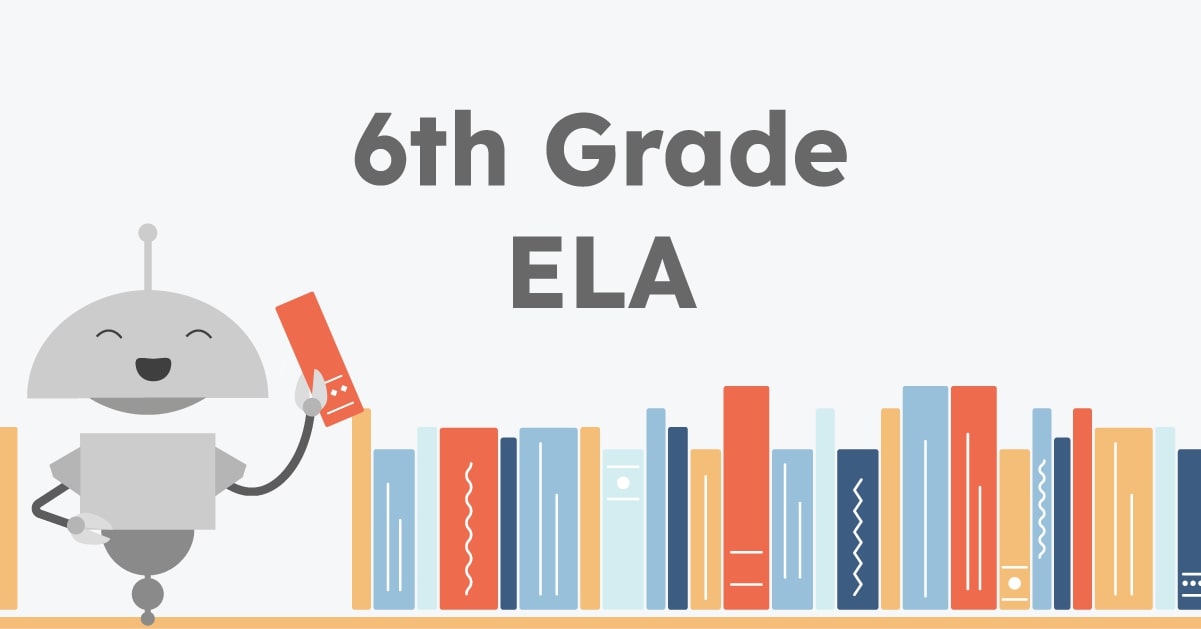6th Grade Language Arts (ELA) Curriculum
Sixth grade is an exciting year — your student has finally graduated from elementary to middle school! Middle school language arts introduces a wide variety of new skills, topics, and discoveries.
In this year, students sharpen their reading, writing, speaking, and language skills as they tackle more complex texts and express their ideas with greater clarity and depth. Through a blend of engaging literature, structured writing practice, and grammar instruction, students build tools for critical thinking and effective communication as they grow as independent learners.
Sample Lesson
Interested in more 6th grade ELA videos? Visit our YouTube channel @TheMiacademyLearningChannel!
Is my student ready for language arts in 6th grade?
Before working on sixth grade reading and writing, we recommend that your child complete our fifth grade ELA courses.
Your student is likely ready for sixth grade language arts if they can:
- Summarize fiction and nonfiction texts accurately
- Identify main idea, theme, and supporting details
- Make inferences and draw conclusions from their reading
- Understand plot, character, setting, and point of view
- Write organized paragraphs with topic and concluding sentences
- Use correct grammar, punctuation, and capitalization
- Create narrative, opinion, and informative pieces of writing
- Revise and edit their writing for clarity and proper grammar
- Present their ideas clearly in both speech and writing
Free ELA 6th Grade Worksheets – PDF Download
Each video lesson has an accompanying PDF with engaging activities to extend learning beyond the screen with a hands-on approach!
Click here to download a free sample PDF of our sixth grade ELA worksheets:
What are the 6th grade ELA standards?
Sixth grade ELA standards aim to deepen student understanding of language by expanding their vocabulary, improving reading fluency, comparing and contrasting different genres, and mastering grammar and sentence structure.
Our sixth grade language arts curriculum supports these standards by helping students become confident readers and writers. While they can vary slightly by state, by the end of the year, students should be able to:
- Cite the texts they’ve read to support their analyses and inferences
- Determine the central idea and accurately summarize texts
- Analyze how plot and character develop over the course of a story
- Interpret figurative language (similes, metaphors, personification, etc.)
- Compare and contrast different genres
- Write clear, well-structured essays (narrative, argumentative, informative)
- Conduct short research projects using multiple sources
- Use proper grammar, punctuation, and spelling in writing
- Engage effectively in collaborative discussions
- Demonstrate vocabulary growth and knowledge of word roots
Standards can vary by state, so be sure to check what’s required where you live.
Scope and Sequence
Language Arts: Level G
Our ELA courses for sixth graders teach essential techniques and strategies that create effective readers and writers. In this course, students begin to craft more complex and organized compositions by thoroughly exploring the writing process. They will also work on clarifying their communication, strengthening their grammar knowledge, and using conjunctions and noun types correctly.
To support your child’s growing vocabulary, we highly recommend that students do our Daily Vocabulary Practice. Expanding their word knowledge helps students better comprehend texts, write with precision, and communicate more effectively in both academics and everyday life.
(6th Grade) Reading Comprehension: Level G
Our sixth grade Reading Comprehension courses strengthen students’ reading skills with a variety of genres. By engaging with everything from fiction and poetry to nonfiction and drama, students not only become more well-rounded readers but also develop a deeper appreciation for different types of literature.
Why is there more than one course?
Miacademy’s language arts curriculum is structured into three different courses, each that focus on a different set of skills:
Learn to Read (Levels A-C only): Focuses on letter sounds, rhyming, and common letter patterns to help kids practice reading for kindergarten to 2nd grade.
Language Skills (All levels): Covers comprehension strategies, grammar, and storytelling techniques to strengthen reading and writing.
Reading Comprehension (Levels C-I only): Provides weekly reading passages with questions to reinforce understanding and apply learned skills.
Students may work at different levels in each area to match their individual learning needs.
Miacademy’s Online 6th Grade Homeschool Curriculum
Our sixth grade ELA curriculum helps students master the essential skills for strong reading and writing across all subjects. By focusing on both analytical reading and purposeful writing, the program prepares students to think critically, communicate effectively, and grow as independent learners.
One of the best things about our sixth grade curriculum is homeschooling with flexibility! You get full customization over your lesson plans and assignments to fit your child’s unique learning needs. Students can skip what they already know and dive into new challenges!
Our family of accredited curricula covers everything from learning to read in elementary to analyzing literature in high school and adapts easily to different grade levels and learning styles.
Whether you’re a full-time homeschool parent or are looking to supplement a public school education, we’re here to support you! Wondering if Miacademy’s sixth grade homeschool curriculum can be a good fit for your student? Start a chat with one of our friendly customer service agents below! They’ll be happy to help you with any questions you may have.



